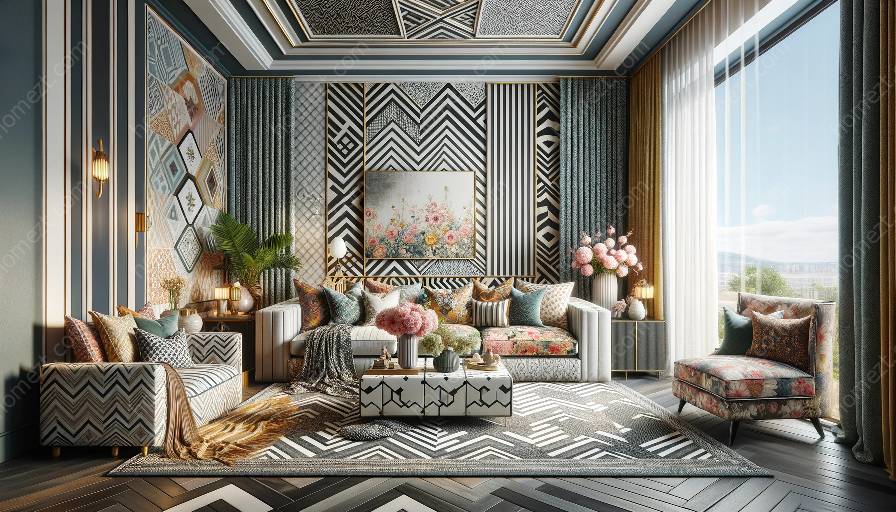Color psychology and pattern mixing have the power to transform a space, creating a harmonious and visually appealing environment. Understanding the effects of different colors and the art of combining patterns can help you infuse personality and style into your home decor while achieving a cohesive and balanced look.
The Influence of Color Psychology on Home Decor
Color psychology explores the psychological impact of colors on human emotions and behavior, making it a valuable tool for decorating your home. Each color has unique properties and can evoke specific feelings and moods, making it essential to consider the psychological impact of different colors when designing your living space.
1. Red: Red is an energetic and bold color that can create a sense of excitement and passion in a room. It is ideal for spaces where you want to stimulate conversation and activity.
2. Blue: Blue is known for its calming and serene qualities, making it perfect for creating a tranquil and relaxing atmosphere in bedrooms or living rooms.
3. Yellow: Yellow is associated with happiness and optimism, adding a cheerful and uplifting vibe to any space. It is great for bringing warmth and positivity into a room.
4. Green: Green represents nature and harmony, making it an ideal choice for creating a peaceful and rejuvenating environment. It can also symbolize growth and freshness.
5. Pink: Pink is often linked to femininity and romance, adding a soft and delicate touch to a room. It can also convey warmth and compassion.
6. Orange: Orange is a vibrant and energizing color that can bring warmth and enthusiasm to a space, making it perfect for creating a lively and welcoming atmosphere.
Understanding the psychological effects of colors allows you to strategically incorporate them into different areas of your home based on the desired ambiance and emotional response.
The Art of Pattern Mixing in Home Decor
Pattern mixing is an art that involves skillfully combining varying patterns, scales, and textures to create an aesthetically pleasing and dynamic space. While it may seem challenging, mastering the art of pattern mixing can lead to visually stunning and personalized home decor.
1. Balance: When mixing patterns, finding a balance is crucial. Incorporate a mix of large-scale, small-scale, and geometric patterns to create visual interest without overwhelming the space.
2. Cohesion: Look for a common color scheme or theme to tie the different patterns together. Cohesion can be achieved through a shared color, style, or motif across the various patterns.
3. Layering: Layering patterns can add depth and dimension to a room. Use patterned rugs, throw pillows, curtains, and upholstery to create texture and visual layers within the space.
4. Experimentation: Don't be afraid to experiment with different patterns and combinations. Mixing florals with stripes, plaids with polka dots, or ethnic prints with abstract designs can result in a creative and eclectic look.
Bringing Color Psychology and Pattern Mixing Together
When decorating your home, combining color psychology with pattern mixing allows you to create a personalized and visually engaging space that reflects your unique style and personality.
1. Harmony: Pairing colors and patterns that complement each other can establish a sense of harmony in a room. For example, pairing calming blue tones with subtle geometric patterns can create a serene and balanced ambiance.
2. Contrast: Using contrasting colors and bold pattern combinations can make a statement and infuse energy into the space. Consider pairing a vibrant red accent wall with mixed patterns in complementary colors to evoke a sense of drama and intrigue.
3. Focal Points: Utilize color and pattern to define focal points within a room. Incorporating a bold patterned area rug or a colorful accent wall can draw the eye and create visual interest within a space.
4. Personal Expression: Embrace color and pattern as a form of self-expression. Choose hues and patterns that resonate with your personality and bring joy and comfort to your living environment.
Implementing Color Psychology and Pattern Mixing in Home Decor
Implementing color psychology and pattern mixing into your home decor requires thoughtful consideration and a creative approach. Here are some practical tips for incorporating these elements into your decorating process:
1. Mood Boards: Create mood boards to visually explore color palettes and pattern combinations. This allows you to experiment with different hues and textures before making design decisions.
2. Sample Swatches: Obtain sample swatches of fabrics and wallpapers to assess how colors and patterns interact in your space. Seeing the materials in the actual environment can help you make informed choices.
3. Layering Accessories: Incorporate patterned throw pillows, accent rugs, and drapes to introduce pattern mixing in a subtle and versatile way. Layering accessories allows for easy updates and alterations to the decor.
4. Accent Walls: Consider creating an accent wall with a bold color or pattern to serve as a focal point in the room, adding depth and visual appeal to the space.
5. Statement Pieces: Introduce statement furniture or artwork with vibrant colors and striking patterns to anchor the decor and create a focal point within the room.
6. Lighting: Utilize lighting fixtures to enhance the impact of color and pattern in a room. Experiment with different lighting schemes to showcase the interplay of colors and patterns.
Conclusion
Color psychology and pattern mixing offer an exciting avenue for creative self-expression and designing a visually captivating home. By understanding the psychological influence of colors and mastering the art of pattern mixing, you can transform your living space into a harmonious and personalized sanctuary that reflects your unique personality and style.






































